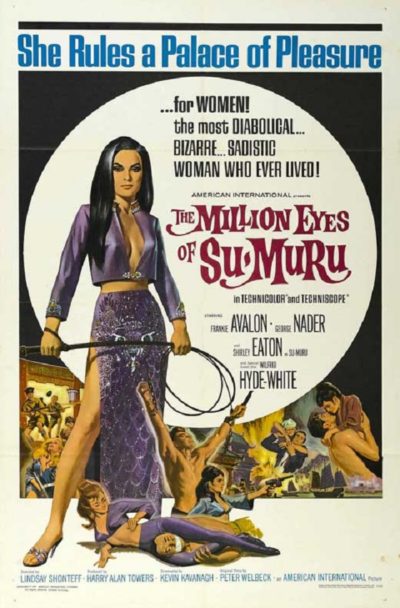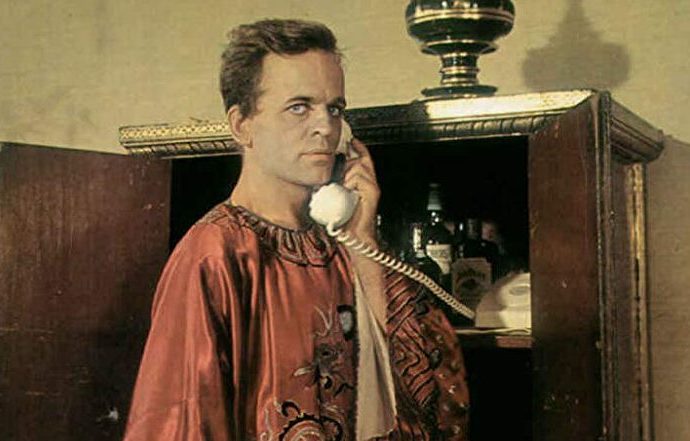Dir: Lindsay Shonteff
Star: George Nader, Shirley Eaton, Frankie Avalon, Klaus Kinski
Made the same year as Five Golden Dragons and for the same producer, Harry Alan Towers, one wonders if the two films were shot back-to-back. Given the same main location (Hong Kong) and overlap of personnel – not just Klaus, but also Maria Rohm – it would make sense not to have shipped the stars out to Hong Kong twice. Especially when Kinski’s role here is little more than a throwaway, a couple of scenes which could easily have been knocked off over the course of a weekend. Quite whether Kinski would have been willing to play another role without demanding a new contract is an obvious question. Yet if anyone could have talked him into it, legendary cinematic hustler Towers would be a good bet.
Also like Dragons, this is clearly not intended to be taken seriously, with the aim being to spoof secret agent movies. Indeed, it could even be regarded as a “mockbuster” version of In Like Flint, itself a spoof of the Bond franchise, which was released in the United States about two months earlier. This stars Nader as CIA agent Nick West, who is out on loan to the British under Colonel Sir Anthony Baisbrook (played by Wilfrid Hyde-White, best known as Prof. Higgins’ sidekick in My Fair Lady). His mission is initially to investigate the murder by drowning of the secretary to the Sinonesian chief of security. The British are interested in keeping that government sweet for oil-related reasons, so call in a favor to the CIA, so West and his sidekick Tommy Carter (Avalon) are sent on the job.
 It’s not long before the chief of security is also a corpse, and West is ordered to take over as his replacement, in order to keep an eye on the leader of Sinonesia, President Boong (Kinski). Which is where his path crosses with the plot of Sumuru (Eaton, famous for being painted to death in Goldfinger), the villain in the piece who is intent on building a world ruled by women. Look, that may seem now like Democratic Party policy (hohoho!). But this was the sixties, and nothing more evil – or, at least, more amusingly evil, at the level appropriate for a tongue in cheek spy flick like this – than a gynocentric society could possibly be imagined for the era. Pat those amusing little ladies on their pert little behinds, and send them back into the kitchen!
It’s not long before the chief of security is also a corpse, and West is ordered to take over as his replacement, in order to keep an eye on the leader of Sinonesia, President Boong (Kinski). Which is where his path crosses with the plot of Sumuru (Eaton, famous for being painted to death in Goldfinger), the villain in the piece who is intent on building a world ruled by women. Look, that may seem now like Democratic Party policy (hohoho!). But this was the sixties, and nothing more evil – or, at least, more amusingly evil, at the level appropriate for a tongue in cheek spy flick like this – than a gynocentric society could possibly be imagined for the era. Pat those amusing little ladies on their pert little behinds, and send them back into the kitchen!
She has sent her spies to become the women behind the world’s most powerful men: “They control millions, and you control them.” The dead secretary was originally one of Sumuru’s agents, until “She has done that one unforgivable thing. She has fallen in love,” and had to be disposed of as a result. Now, they’re going straight for Boong, and it’s up to Agent West to foil their dastardly plan. Of course, it helps that just about every woman who crosses his path falls for him, including Helga (Rohm), sent to kill Boong, and even Sumuru herself, leading to the following, remarkably sixties-esque, line from the wannabe evil overlordess: “I need a man, Nick. I need a man to take me, to force himself upon me.”
Really, it’s all so staggeringly chauvinist as to make me want to burn my bra and march on Hollywood, demanding change. Which is odd, since in having a woman as the main villain was decades ahead of its time. If only they had actually treated her as a worthy opponent for West, rather than give her statements like “Look at me. Whatever else I am, I am a woman…” Yet, such an uncomfortable dichotomy was not unique to this movie. The same period also gave us Deadlier Than The Male and the Doctor Goldfoot franchise; while the villains in all those were male, they each used women (robotic women, in the case of Goldfoot) to carry out their evil schemes.
Kinski’s part is almost a nothingburger, though his President is a weird character, to say the least. We hear how “Boong’s turnover in girls is tastelessly high.” Yet the way Klaus portrays him is almost flamboyantly gay, and so clumsy and incompetent, it’s impossible to figure out how he could have become president of anything larger than a sand-box. There is a nice moment where Helga refuses to go through with her ordered assassination of the leader, after having second thoughts, before one of Boong’s guards steps up to kill her employer instead – only for the victim to turn out to be a lookalike. So perhaps the President isn’t quite as dumb as he seems. For the sake of Sinonesia, I certainly hope that’s the case.
As a whole, the movie doesn’t work for a contemporary viewer, being neither amusing nor exciting, and filled with badly dated attitudes to both race and gender. Nader’s lack of charisma doesn’t help; according to Wikipedia, he was “discretely gay”, which may help explain the lack of sizzle in his scenes with Eaton. Mind you, given the best-known movie in his filmography is probably the horrendously-awful Robot Monster, it’s no wonder this is largely forgettable. As his sidekick, Avalon (who was also in the first Dr. Goldfoot film) brings much the same perkily clean-cut charm he had with Annette Funicello in the Beach Party movies. Eaton is surprisingly good as the bad girl, though the biggest shock is seeing the woman who played one of the most iconic blonde bit-parts in cinema history, with dark hair.
The film was based on the works of pulp author Sax Rohmer, the author behind Fu Manchu (also filmed by Towers, with Christopher Lee). Initially, Sumuru was created for a BBC radio serial just after the war, then became a series of novels, published from 1950-56. This movie ends with Susumu’s lair being destroyed, yet she slips away, and re-appeared in another Towers film, two years later: The Girl From Rio, directed by Jess Franco. Rohm also appears in that one, playing a different character; however, there was no room for Klaus, despite being in several Towers/Franco films around the time, such as Deadly Sanctuary and Count Dracula.
